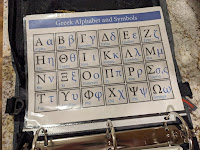Venus and Mars the night of my first outing, June 2021
When I started doing this in the summer of 2021, my only tools were imagination. This took me to a lot of places and I knew some of the points in the sky already. As my interest literally exploded, I discovered a large number of other resources for finding what's out there. This entry will go over my preparations and procedures for my sessions as they are today.
********************
 |
| A typical planner compiled for several nights of observing |
If the night is dark enough, I've been planning several sets. One is a seasonal Messier list where I just completed everything for winter. Another I just started where I'm wanting to observe all the stars in zodiacal constellations. Some of those will be busier than others. Then there's others I'm choosing from "Turn Left at Orion". Just the other night I revisited my "Lunar 100" list. Whatever I'm working on in that regard, I'll enter them into a planner I've got in my Google drive. Some kind of planning is good to organize viewing sessions once a new hobbyist's "point-and-look" phase has come and gone. I still list the RA and Declination even though my Dob is an Alt-Az mount. I think I do that mainly because my IAU charts (most charts in fact) map objects using those coordinates.
To help me find items, I have several reference tools at my disposal:

I have this all-weather binder with the first pages showing a legend for the chart symbols, followed by a graphic showing me the Greek alphabet to help with the star designations.
 |
| My IAU charts with the constellations A-Z |
 |
| Messier object charts with Telrad targets drawn |
 |
| Caldwell objects with Telrad targets |
 |
| NGC objects with Telrad Targets |
If I'm working on lunar targets, I have a spreadsheet I found here: Lunar 100. I also have a virtual lunar atlas on a laptop to help me attain the target. That was especially helpful the other night as the moon was nearly full and the lack of shadows made it very hard to find items on the list.
Next I have a number of ways to zero in on my target. They go from old school to the latest and greatest.
The right-angle finder scope actually has two functions. First is the obvious which is to help find objects. Second, the 8x50 view can act as a monocular to get closer views of wide-field objects like the Pleiades which sometimes a scope can overwhelm. The Telrad is an excellent way to target areas of the sky using the charts illustrated above. Finally, the mobile phone with Astrohopper gets me right on the money for just about everything. The only caveat is the mobile has no cell service, so without WiFi the Astrohopper will not function. I'm wanting to look into adding a hotspot function to my mobile mainly to allow the Astrohopper to connect.
********************
Heading outside, I almost always grab the 8" Dobsonian. Unless I'm viewing the sun or moon (I took out the 130mm EQ for the moon the other night) I want something with a wider aperture. I'm leaning more and more towards this being a visual activity. I tried sketching but it feels like too much a demand on time I could use simply looking. I dipped my toes into astrophotography, but without real tracking my results will be limited (a Dwarf 2 is on my wish list for that very thing).
Just curious, I wonder how many folks out there actually sit while using their scope? I can do that if I have one object for the whole session, however the act of "making the rounds" has me moving around too much. I'll sit when taking notes or doing log entries (or the very occasional beer), but moving from one end of the sky or the other, or making adjustments on my EQ, has me up and about fairly frequently.
Now my Dob does require a bit of a lift, and my wife's patio table is the perfect height:
 |
| The table goes with me in the field, too. |
The first time I took the Dob to a dark sky location, I forgot the table and spent many painful moments kneeling on the gravelly parking lot surface. Last Halloween, someone nearby setup his scope on the sidewalk to allow trick-or-treaters a look at Saturn. I thought that was a great thing to do and may just follow suit this October. For that, I would eschew the table so littler ones can get a good look.
 |
| My images of Saturn over time |
********************
I'm planning another Oracle trip for the next new moon. No WiFi for the A-hop so I will need to get things ready to do this old school. I went out last week, but between the soupy air and the neighbor's lighting it was an uphill battle. I hope to have some news on this next time.
 |
Astrometry annotated constellations from my last Oracle pic
|














Comments
Post a Comment